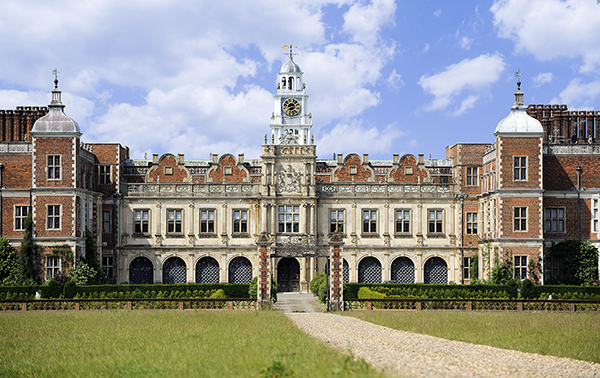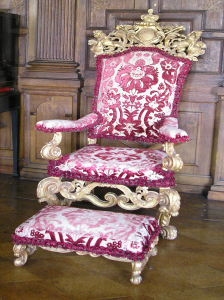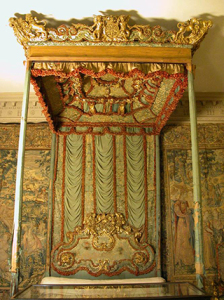National Trust Curator of Furniture Research examines historic thrones in modern collections. Enjoy Wolf’s insights on a bespoke tour this September – join us on our Heritage Circle Study Day in London. Learn More
By Dr. Wolf Burchard
Today, there are more royal throne chairs in British private collections than in the British Royal Collection. This is because, until the nineteenth century, a vast quantity of furniture was given away at the end of each reign, allowing new monarchs to refurnish their palaces with their personal insignia and according to latest fashions thereby supporting London furniture makers and upholsterers. The pieces of furniture remaining from the deceased monarch were acquired by senior courtiers, receiving pieces appropriate to their respective rank. Royal thrones can be found at Chatsworth, Grimsthorpe Castle, Houghton Hall, etc. Hatfield House, the Jacobean seat of the Marquess of Salisbury, preserves one of the oldest surviving royal thrones: the chair of state used at Queen Anne’s coronation. Its elaborate frame was made by the royal chair-maker Thomas Roberts in 1702 for £20 – a sum dramatically contrasting with £72 spent on its upholstery…

The south front of Hatfield House
Thomas Roberts (active between 1684 and 1714) was a carver and joiner and principal supplier of bed and seat furniture for the royal palaces. He had a workshop on Marylebone Street, Westminster, London, rather appropriately named ‘The Royal Chair’. The National Trust owns several pieces of seat furniture associated with the work of Thomas Roberts, even if sometimes the attribution cannot be made with utmost certainty.
An extraordinary pair of armchairs at Hardwick Hall, in Derbyshire, reflects the Baroque boldness of Roberts’s designs. His work from the late 1690s is said to have been heavily influenced by Continental fashions, such as the French ‘cross-stretchers’ uniting the legs. Although undocumented, it is possible that the chairs were supplied by Roberts for William Cavendish, 1st Duke of Devonshire in 1697 to accompany a state bed made by Francis Lapiere for Chatsworth, since turned into a state canopy, or rather a coup d’œil of genius, installed in the Gallery at Hardwick by the 6th Duke of Devonshire (NT 1127772;
Knole in Kent, equally comprises a state bed, with the crown, supporters and arms of James II, with matching seat furniture attributed to Thomas Roberts. The very impressive, richly carved and gilded bed with fine hangings of blue-green Genoa velvet, currently being conserved, was ordered by the Great Wardrobe for James II’s apartments at Whitehall Palace in August 1688 – only three months before the King was exiled to France. The bed, together with the matching pair of armchairs and the six stools form one of the most spectacular and historically important sets of late Stuart furniture in existence.
In 1714, ‘The Royal Chair’ was taken over by Richard Roberts, presumed to have been Thomas’s son. Richard continued to supply furniture for the Royal Household, including George I’s coronation throne. This particular chair, now in a private collection, once again appears to reflect continental influences on English furniture. Many furniture historians are desperate for attributions. Linking certain pieces to a famous craftsman such as Thomas Chippendale, André-Charles Boulle or Abraham Roentgen arguably adds to its importance. This may also be said about Thomas and Richard Robert’s work. However, attributions remain extremely problematic due to the lack of documentary evidence and comparative examples. One solution would be to gather all the works attributed to the renowned chair-maker in one space and compare each chair’s structure, carvings, finish etc. This could help demystify the enigmatic Thomas and Richard Roberts.
Further readings:
‘Roberts, Thomas and Richard’ in Geoffrey Beard and Christopher Gilbert (eds), The Dictionary of English Furniture Makers, 1660-1840, Leeds 1986, pp. 752-4.
Sarah Medlam, ‘Chair of state and footstool used at the coronation of Queen Anne’ in Michael Snodin and Nigel Llewellyn (ed.), Baroque, 1620–1800. Style in the Age of Magnificence (ex. cat.), London 2009, no. 148, pp. 350–1.
Adam Bowett, English Furniture, 1660-1714. From Charles II to Queen Anne, Woodbrigde 2004, pp. 240-243 and ‘George I’s Coronation Throne’, Apollo vol. CLXI, no. 515 (January 2005), pp. 42–7.
Hugh Roberts, ‘Royal Thrones, 1760–1840’, Furniture History XXV (1989), pp. 61–85 and ‘Thrones Revisited’, Furniture History XLIII (2007), pp. 43–54.
Wolf Burchard and Sebastian Edward, ‘A Very Royal Perquisite: The eventful Life of George I’s Coronation Throne’, The Furniture History Society Newsletter, no. 195 (August 2014), pp. 5-9.





